Search results for: 'comb''
- Related search terms
- comb''
-
 AUTEFA, DILO, SPINNBAU NEEDLE-PUNCHING COMPLETE LINEREFERENCE NUMBER: T-6852 AUTEFA, DILO, SPINNBAU NEEDLE-PUNCHING COMPLETE LINE BRAND: AUTEFA, DILO, SPINNBAU SHORT DESCRIPTION: NEEDLE-PUNCHING COMPLETE LINE 3° NEEDLE-PUNCHING COMPLETE LINE (1970 CA.) COMPOSED OF: 1 SINGLE DOFFER CARD BY “BESSI” WORKING WIDTH 2500mm - HOPPER-FEEDER “TEMAFA” WITH SCALE (WEIGHPAN) AND TOP SILO - BREAST UNIT DIAMETER 1500mm WITH 7 PAIRS WORKERS/STRIPPER DIAMETER 220/74, RIGID METALLIC WIRES STILL USABLE 60% APPROX. - TRANSPORT ROLL DIAMETER 1285mm, RIGID WIRES STILL USABLE FOR 80% APPOX - SWIFT DIAMETER 1500mm, 6 PAIRS WORKERS/STRIPPER DIAMETER 215/74, SWIFT WITH RIGID WIRES STILL USABLE 90% CA., FLEXIBLE WIRES FOR WORKERS STILL USABLE 80% APPROX - DOFFER DIAMETER 1500mm, FRIGID WIRES STILL USABLE 90% APPROX. - FLY-COMB 1 CROSSLAPPER “MAK-AUTEFA”, INLET WORKING WIDTH 2500mm, EXIT WORKING WIDTH 3000mm 1 PRE-NEEDLER “DILO” NFZ25, MATR. 2387/1965, NO. 2580 NEEDLES/LM WITH MOBILE STRIPPER PLATE FOR HEAVY FELTS 1500 GRS/SQM AND/OR VOLUMINOUS FIBERS 2 LONGITUDINAL CUT “MACCHI” 1 TRANSVERSAL CUT “SPINNBAU” 1 WINDER IN WEIGHTING CELLS (METTLER) QUANTITY: 1 Learn More
AUTEFA, DILO, SPINNBAU NEEDLE-PUNCHING COMPLETE LINEREFERENCE NUMBER: T-6852 AUTEFA, DILO, SPINNBAU NEEDLE-PUNCHING COMPLETE LINE BRAND: AUTEFA, DILO, SPINNBAU SHORT DESCRIPTION: NEEDLE-PUNCHING COMPLETE LINE 3° NEEDLE-PUNCHING COMPLETE LINE (1970 CA.) COMPOSED OF: 1 SINGLE DOFFER CARD BY “BESSI” WORKING WIDTH 2500mm - HOPPER-FEEDER “TEMAFA” WITH SCALE (WEIGHPAN) AND TOP SILO - BREAST UNIT DIAMETER 1500mm WITH 7 PAIRS WORKERS/STRIPPER DIAMETER 220/74, RIGID METALLIC WIRES STILL USABLE 60% APPROX. - TRANSPORT ROLL DIAMETER 1285mm, RIGID WIRES STILL USABLE FOR 80% APPOX - SWIFT DIAMETER 1500mm, 6 PAIRS WORKERS/STRIPPER DIAMETER 215/74, SWIFT WITH RIGID WIRES STILL USABLE 90% CA., FLEXIBLE WIRES FOR WORKERS STILL USABLE 80% APPROX - DOFFER DIAMETER 1500mm, FRIGID WIRES STILL USABLE 90% APPROX. - FLY-COMB 1 CROSSLAPPER “MAK-AUTEFA”, INLET WORKING WIDTH 2500mm, EXIT WORKING WIDTH 3000mm 1 PRE-NEEDLER “DILO” NFZ25, MATR. 2387/1965, NO. 2580 NEEDLES/LM WITH MOBILE STRIPPER PLATE FOR HEAVY FELTS 1500 GRS/SQM AND/OR VOLUMINOUS FIBERS 2 LONGITUDINAL CUT “MACCHI” 1 TRANSVERSAL CUT “SPINNBAU” 1 WINDER IN WEIGHTING CELLS (METTLER) QUANTITY: 1 Learn More -
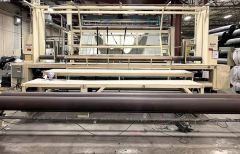 AUTOMATEX, SPINNBAU NEEDLE PUNCH LINEREFERENCE NUMBER: T-6840 AUTOMATEX, SPINNBAU NEEDLE PUNCH LINE BRAND: AUTOMATEX, SPINNBAU NEEDLE PUNCH LINE CONSISTING OF: BLEND LINE, 60” WIDE, 4 HOPPERS WITH 12 HEAVY DUTY EXTENDED APRONS & NEW ELECTRONIC WEIGHING SYSTEM (2016). ALL MACHINES COMPLETELY RECONDITIONED IN 2016. OMMI STACK RESERVE, AUTOMATIC COMBO 332, YEAR 2000 SPINNBAU CARD, 2500mm, DOUBLE DOFFER, YEAR 1995, REPORTED ~1500 TO 1800 PPH CAPACITY DEPENDING UPON PRODUCT. AUTOMATEX FA/3000 TC CROSSLAPPER, YEAR 1997, AC DRIVES. BATT DRAFTER, 12 ROLLS. AUTOMATEX PR-100/T PRE-NEEDLER, 60mm STROKE, YEAR 1997 DRAFTER, 5 ROLLS. AUTOMATEX AG 154/TB NEEDLE LOOM, QUAD PUNCH, 50mm STROKE, YEAR 1997 FOUR ROLL STRETCH. METAL DETECTOR. ENTEX TENTER WITH VERTICAL IR HEAT BANKS, YEAR 1997 WINDER, YEAR 1997 PERKINS 4 ROLL CALENDER, NO STEEL ROLLS OR HEAT SYSTEM INCLUDED BUT MIGHT BE NEGOTIATED. EHHARDT+LEIMER GUIDER MODEL SE 11062, YEAR 2013 ENTEC WINDER, YEAR 1997 FINISHED WIDTH REPORTED OF 210" BUT COULD GO WIDER. LINE RAN PRIMARILY GEOTEXTILE & BEDDING PRODUCTS FROM 4.5 TO 10 OZ/YD. QUANTITY: 1 Learn More
AUTOMATEX, SPINNBAU NEEDLE PUNCH LINEREFERENCE NUMBER: T-6840 AUTOMATEX, SPINNBAU NEEDLE PUNCH LINE BRAND: AUTOMATEX, SPINNBAU NEEDLE PUNCH LINE CONSISTING OF: BLEND LINE, 60” WIDE, 4 HOPPERS WITH 12 HEAVY DUTY EXTENDED APRONS & NEW ELECTRONIC WEIGHING SYSTEM (2016). ALL MACHINES COMPLETELY RECONDITIONED IN 2016. OMMI STACK RESERVE, AUTOMATIC COMBO 332, YEAR 2000 SPINNBAU CARD, 2500mm, DOUBLE DOFFER, YEAR 1995, REPORTED ~1500 TO 1800 PPH CAPACITY DEPENDING UPON PRODUCT. AUTOMATEX FA/3000 TC CROSSLAPPER, YEAR 1997, AC DRIVES. BATT DRAFTER, 12 ROLLS. AUTOMATEX PR-100/T PRE-NEEDLER, 60mm STROKE, YEAR 1997 DRAFTER, 5 ROLLS. AUTOMATEX AG 154/TB NEEDLE LOOM, QUAD PUNCH, 50mm STROKE, YEAR 1997 FOUR ROLL STRETCH. METAL DETECTOR. ENTEX TENTER WITH VERTICAL IR HEAT BANKS, YEAR 1997 WINDER, YEAR 1997 PERKINS 4 ROLL CALENDER, NO STEEL ROLLS OR HEAT SYSTEM INCLUDED BUT MIGHT BE NEGOTIATED. EHHARDT+LEIMER GUIDER MODEL SE 11062, YEAR 2013 ENTEC WINDER, YEAR 1997 FINISHED WIDTH REPORTED OF 210" BUT COULD GO WIDER. LINE RAN PRIMARILY GEOTEXTILE & BEDDING PRODUCTS FROM 4.5 TO 10 OZ/YD. QUANTITY: 1 Learn More -
 AUTEFA, TEMAFA NONWOVEN LINE, YEAR 1970REFERENCE NUMBER: T-6839 AUTEFA, TEMAFA NONWOVEN LINE, YEAR 1970 BRAND: AUTEFA, TEMAFA SHORT DESCRIPTION: NONWOVEN LINE YEAR: 1970 SUITABLE FOR A PRODUCTION OF: 700/800 GRS/SQUARE METER COMPOSED OF: 1 BESSI CARDING MACHINE, WORKING WIDTH 2500mm -TEMAFA FEEDER -BREAST ROLLER DIAMETER 1500mm, 7 COUPLE OF WORKERS, DIAMETER 220/74 -DOFFER DIAMETER 1285mm -DRUM DIAMETER 1500mm, 6 COUPLE OF WORKERS -DOFFER DIAMETER 1500mm -FLY COMB 1 AUTEFA CROSS LAPPER MODEL MAK IN WORKING WIDTH 2500mm, DELIVERY 3000mm 1 DILO NFZ25 PRE-NEEDLING MACHINE, YEAR 1965, 2580 NEEDLES /METER 2 MACCHI LONGITUDINAL CUTTERS 1 SPINBAU TRANSVERSAL CUTTER 1 WINDER ON WEIGHS (LOADING CELLS METTLER) QUANTITY: 1 Learn More
AUTEFA, TEMAFA NONWOVEN LINE, YEAR 1970REFERENCE NUMBER: T-6839 AUTEFA, TEMAFA NONWOVEN LINE, YEAR 1970 BRAND: AUTEFA, TEMAFA SHORT DESCRIPTION: NONWOVEN LINE YEAR: 1970 SUITABLE FOR A PRODUCTION OF: 700/800 GRS/SQUARE METER COMPOSED OF: 1 BESSI CARDING MACHINE, WORKING WIDTH 2500mm -TEMAFA FEEDER -BREAST ROLLER DIAMETER 1500mm, 7 COUPLE OF WORKERS, DIAMETER 220/74 -DOFFER DIAMETER 1285mm -DRUM DIAMETER 1500mm, 6 COUPLE OF WORKERS -DOFFER DIAMETER 1500mm -FLY COMB 1 AUTEFA CROSS LAPPER MODEL MAK IN WORKING WIDTH 2500mm, DELIVERY 3000mm 1 DILO NFZ25 PRE-NEEDLING MACHINE, YEAR 1965, 2580 NEEDLES /METER 2 MACCHI LONGITUDINAL CUTTERS 1 SPINBAU TRANSVERSAL CUTTER 1 WINDER ON WEIGHS (LOADING CELLS METTLER) QUANTITY: 1 Learn More -
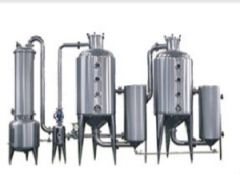 DOUBLE EFFECT EVAPORATORREFERENCE NUMBER: P-8843-A DOUBLE EFFECT EVAPORATOR FEATURES: COMBINES THE EXTERNAL CIRCULATION HEATING SYSTEM WITH THE WAY OF VACUUM CONCENTRATION TOGETHER IN ORDER TO ENHANCE THE EVAPORATION SPEED. N2-500 EVAPORATION CAPACITY (Kg/h): 500 STEAM CONSUMPTION: 380 TEMPERATURE (0C): SINGLE EFFECT 80 TO 90 VACUUM DEGREE(MPA): SINGLE EFFECT 0.02 TO 0.04 CIRCULATION WATER(t/h): 10 TO 15 DIMENSION (mm): 4500x1000x3200 QUANTITY: 1 Learn More
DOUBLE EFFECT EVAPORATORREFERENCE NUMBER: P-8843-A DOUBLE EFFECT EVAPORATOR FEATURES: COMBINES THE EXTERNAL CIRCULATION HEATING SYSTEM WITH THE WAY OF VACUUM CONCENTRATION TOGETHER IN ORDER TO ENHANCE THE EVAPORATION SPEED. N2-500 EVAPORATION CAPACITY (Kg/h): 500 STEAM CONSUMPTION: 380 TEMPERATURE (0C): SINGLE EFFECT 80 TO 90 VACUUM DEGREE(MPA): SINGLE EFFECT 0.02 TO 0.04 CIRCULATION WATER(t/h): 10 TO 15 DIMENSION (mm): 4500x1000x3200 QUANTITY: 1 Learn More -
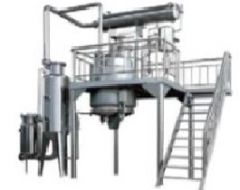 MULTI FUNCTION EXTRACTING TANKREFERENCE NUMBER: P-8842 MULTI FUNCTION EXTRACTING TANK APPLICATION: IT IS USED FOR EXTRACTING, CONCENTRATING, SOLVENT RECOVERY AND AROMATIC OIL COLLECTION FOR MEDICINAL HERB AND MANY PLANTS. FEATURES: IT INCLUDES EXTRACTING TANK, SINGLE-EFFECT EXTERNAL CIRCULATION CONCENTRATOR TOGETHER WITH OTHER AUXILIARY EQUIPMENT. IT HAS COMBINING EXACTING, CONDENSATION, SOLVENT RECOVERY FUNCTION WITH FEATURES OF COMPACT STRUCTURE AND EASY OPERATION. QUANTITY: 1 Learn More
MULTI FUNCTION EXTRACTING TANKREFERENCE NUMBER: P-8842 MULTI FUNCTION EXTRACTING TANK APPLICATION: IT IS USED FOR EXTRACTING, CONCENTRATING, SOLVENT RECOVERY AND AROMATIC OIL COLLECTION FOR MEDICINAL HERB AND MANY PLANTS. FEATURES: IT INCLUDES EXTRACTING TANK, SINGLE-EFFECT EXTERNAL CIRCULATION CONCENTRATOR TOGETHER WITH OTHER AUXILIARY EQUIPMENT. IT HAS COMBINING EXACTING, CONDENSATION, SOLVENT RECOVERY FUNCTION WITH FEATURES OF COMPACT STRUCTURE AND EASY OPERATION. QUANTITY: 1 Learn More -
 P-8704 PROTECTIVE SUIT
P-8704 PROTECTIVE SUITREFERENCE NUMBER: P-8704
PROTECTIVE SUIT
MEETS THE TECHNICAL REQUIREMENTS FOR CE AND FDA
HIGH GRAM WEIGHT NONWOVENS OF 68G/M²
ENHANCED WATER RESISTANCE, SYNTHETIC BLOOD PENETRATION RESISTANCE
PREVENT PARTICLES EFFECTIVELY
TYPE 5 AND TYPE 6 PROTECTION
SPE COATING: MOISTURE PROOF, BREATHABLE, FLEXIBLE, NON COMBUSTIBLEHIGH STRENGTH AND TENSILITY
DURABLE AND TEAR RESISTANCE
ANTISTATIC TREATMENT
REDUCE THE ABSORPTION OF HARMFUL SUBSTANCE
SELASTICATED WRISTS, ANKLES AND FACES, HOODED COVERALL
SELF ADHESIVE ZIPPER
CARTON SIZE: 49X45X44mm
GW: 8.50KG
IN A CARTON: 25PCS
QUANTITY: 1
Learn More -
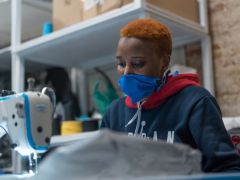 D-2388 What’s the Best Material for a Mask?
D-2388 What’s the Best Material for a Mask?Federal health officials have now recommended that we cover our faces with fabric during the coronavirus pandemic. But what material offers the most protection?
The Centers for Disease Control and Prevention has posted a no-sew mask pattern using a bandanna and a coffee filter as well as a video on making masks using rubber bands and folded fabrics found at home.
While a simple face covering can reduce the spread of coronavirus by blocking outgoing germs from coughs or sneezes of an infected person, experts say there is more variation in how much homemade masks might protect the wearer from incoming germs, depending on the fit and quality of the material used.
Scientists around the country have taken it upon themselves to identify everyday materials that do a better job of filtering microscopic particles. In recent tests, HEPA furnace filters scored well, as did vacuum cleaner bags, layers of 600-count pillowcases and fabric similar to flannel pajamas. Stacked coffee filters had medium scores. Scarves and bandanna material had the lowest scores, but still captured a small percentage of particles.
If you don’t have any of the materials that were tested, a simple light test can help you decide whether a fabric is a good candidate for a mask.
“Hold it up to a bright light,” said Dr. Scott Segal, chairman of anesthesiology at Wake Forest Baptist Health who recently studied homemade masks. “If light passes really easily through the fibers and you can almost see the fibers, it’s not a good fabric. If it’s a denser weave of thicker material and light doesn’t pass through it as much, that’s the material you want to use.”
Researchers say it’s important to remember that lab studies are conducted under perfect conditions with no leaks or gaps in the mask, but the test methods give us a way to compare materials. And while the degree of filtration for some homemade masks seems low, most of us — who are staying home and practicing social distancing in public — don’t need the high level of protection required for medical workers. More important, any face covering is better than none, especially if worn by a person who has the virus but doesn’t know it.
The biggest challenge of choosing a homemade mask material is to find a fabric that is dense enough to capture viral particles, but breathable enough that we can actually wear it. Some items being touted online promise high filtration scores, but the material would be unwearable.
Dressing Up for Work … at Home
Yang Wang, an assistant professor of environmental engineering at Missouri University of Science and Technology, worked with his graduate students to study various combinations of layered materials — including both air filters and fabric. “You need something that is efficient for removing particles, but you also need to breathe,” said Dr. Wang, who last fall won an international award for aerosol research.To test everyday materials, scientists are using methods similar to those used to test medical masks, which everybody agrees should be saved for medical workers who are exposed to high doses of virus from seeing infected patients. The best medical mask — called the N95 respirator — filters out at least 95 percent of particles as small as 0.3 microns. By comparison, a typical surgical mask — made using a rectangular piece of pleated fabric with elastic ear loops — has a filtration efficiency ranging from 60 to 80 percent.
Dr. Wang’s group tested two types of air filters. An allergy-reduction HVAC filter worked the best, capturing 89 percent of particles with one layer and 94 percent with two layers. A furnace filter captured 75 percent with two layers, but required six layers to achieve 95 percent. To find a filter similar to those tested, look for a minimum efficiency reporting value (MERV) rating of 12 or higher or a microparticle performance rating of 1900 or higher.
The problem with air filters is that they potentially could shed small fibers that would be risky to inhale. So if you want to use a filter, you need to sandwich the filter between two layers of cotton fabric. Dr. Wang said one of his grad students made his own mask by following the instructions in the C.D.C. video, but adding several layers of filter material inside a bandanna.
Dr. Wang’s group also found that when certain common fabrics were used, two layers offered far less protection than four layers. A 600 thread count pillow case captured just 22 percent of particles when doubled, but four layers captured nearly 60 percent. A thick woolen yarn scarf filtered 21 percent of particles in two layers, and 48.8 percent in four layers. A 100 percent cotton bandanna did the worst, capturing only 18.2 percent when doubled, and just 19.5 percent in four layers.
The group also tested Brew Rite and Natural Brew basket-style coffee filters, which, when stacked in three layers, showed 40 to 50 percent filtration efficiency — but they were less breathable than other options.
If you are lucky enough to know a quilter, ask them to make you a mask. Tests performed at the Wake Forest Institute for Regenerative Medicine in Winston-Salem, N.C., showed good results for homemade masks using quilting fabric. Dr. Segal, of Wake Forest Baptist Health, who led the study, noted that quilters tend to use high-quality, high-thread count cotton. The best homemade masks in his study were as good as surgical masks or slightly better, testing in the range of 70 to 79 percent filtration. Homemade masks that used flimsier fabric tested as low as 1 percent filtration, Dr. Segal said.
The best-performing designs were a mask constructed of two layers of high-quality, heavyweight “quilter’s cotton,” a two-layer mask made with thick batik fabric, and a double-layer mask with an inner layer of flannel and outer layer of cotton.
Bonnie Browning, executive show director for the American Quilter’s Society, said that quilters prefer tightly woven cottons and batik fabrics that stand up over time. Ms. Browning said most sewing machines can handle only two layers of fabric when making a pleated mask, but someone who wanted four layers of protection could wear two masks at a time.
Ms. Browning said she recently reached out to quilters on Facebook and heard from 71 people who have made a combined total of nearly 15,000 masks. “We quilters are very much in the thick of what’s going on with this,” said Ms. Browning, who lives in Paducah, Ky. “One thing most of us have is a stash of fabric.”
People who don’t sew could try a folded origami mask, created by Jiangmei Wu, assistant professor of interior design at Indiana University. Ms. Wu, who is known for her breathtaking folded artwork, said she began designing a folded mask out of a medical and building material called Tyvek, as well as vacuum bags, after her brother in Hong Kong, where mask wearing is common, suggested it. (DuPont, the maker of Tyvek, said in a statement that Tyvek is intended for medical apparel, not masks.) The folded mask pattern is free online, as is a video demonstrating the folding process. In tests at Missouri University and University of Virginia, scientists found that vacuum bags removed between 60 percent and 87 percent of particles. But some brands of vacuum bags may contain fiberglass or are harder to breathe through than other materials, and shouldn’t be used. Ms. Wu used a bag by EnviroCare Technologies, which has said it does not use fiberglass in its paper and synthetic cloth bags.
“I wanted to create an alternative for people who don’t sew,” said Ms. Wu, who said she is talking to various groups to find other materials that will be effective in a folded mask. “Given the shortage of all kinds of materials, even vacuum bags might run out.”
The scientists who conducted the tests used a standard of 0.3 microns because that is the measure used by the National Institute for Occupational Safety and Health for medical masks.
Linsey Marr, a Virginia Tech aerosol scientist and an expert in the transmission of viruses, said the certification method for respirators and HEPA filters focuses on 0.3 microns because particles around that size are the hardest to catch. While it seems counterintuitive, particles smaller than 0.1 microns are actually easier to catch because they have a lot of random motion that makes them bump into the filter fibers, she said.
“Even though coronavirus is around 0.1 microns, it floats around in a wide range of sizes, from around 0.2 to several hundred microns, because people shed the virus in respiratory fluid droplets that also contain lots of salts and proteins and other things,” said Dr. Marr. “Even if the water in the droplets fully evaporates, there’s still a lot of salt and proteins and other gunk that stays behind as solid or gel-like material. I think 0.3 microns is still useful for guidance because the minimum filtration efficiency will be somewhere around this size, and it’s what NIOSH uses.”
Learn More -
 How To Choose an N95 Respirator Mask For Coronavirus Prevention? All You Need to Know Before Buying Face Masks
How To Choose an N95 Respirator Mask For Coronavirus Prevention? All You Need to Know Before Buying Face MasksHow To Choose an N95 Respirator Mask For Coronavirus Prevention? All You Need to Know Before Buying Face Masks.
1. What’s an N95 mask?
An N95 respirator is a respiratory protective face mask, designed to help reduce the user’s exposure to airborne particles including very small particles (0.3 microns) and large droplets. N95 respirator face mask literally has a filtration efficiency of at least 95% against non-oily particles.
2. Differences between N95 mask and surgical mask?
Generally, the N95mask also includes an N95 surgical mask. So, here we will just compare a standard N95 particulate mask with a disposable surgical mask. Surgical masks are designed to be worn by healthcare professionals during surgery and nursing, to help prevent contamination of the surgical field or the patient by capturing liquid droplets that are expelled by the user.
An N95 particulate mask blocks at least 95 percent of very small (0.3 microns) test particles, and while a disposable surgical mask is fluid-resistant and protects the user against large particles (5 microns), droplets, sprays or splatter.
Different from a loose-fitting, disposable surgical mask, an N5 mask is tight-fitting to achieve a very close facial fit, which guarantees a minimal leakage around the edges of the mask when the user inhales. If properly fitted, the filtration capabilities of N95 respirators exceed those of disposable surgical face masks.Speaking of the N95 mask price and disposable surgical mask price, the N95 respirator mask is pricier than a surgical mask. In contrast, the N95 mask is reusable but the common surgical mask is disposable. Strictly speaking, N95 respirator masks should be worn for a maximum of eight hours while the disposable surgical mask is recommended to be replaced every four hours.
However, during the novel coronavirus outbreak, face masks are in short supply and everyone discards one or two face masks every day. A surgical mask could be used for a whole day in a good condition of no damage, no moisture, and no deformation. According to some researches, the N95 respirator mask used for two days still maintains a filtration efficiency of at least 95%, while the filtration efficiency of an N95 respirator used for three days reduced to 94.7%. So, if an N95 respirator is in good maintenance, you can wear it for at least 2 days, a week, maybe even a month.
3. Types of N95 mask
Generally, according to their intended use, the types of N95 masks include the standard N95 particulate respirators and N95 surgical respirator masks. Additionally, there are N95 masks with a breathing valve or not.
1) Differences between standard N95 particulate respirator and N95 surgical mask:
How to differentiate standard N95 particulate-filtering respirators and N95 surgical masks? The N95 surgical mask is literally a combination of N95 respirator and surgical mask, it is both certificated by NIOSH as an N95 respirator and also cleared by the FDA as a surgical mask. N95 surgical respirator masks are also referred to as medical respirators, healthcare respirators, or surgical N95s.
The significant difference between a standard N95 particulate respirator and an N95 surgical mask is that the N95 surgical mask is fluid-resistant while the standard N95 particulate respirator is not.
An N95 particulate respirator, also called N95 dust mask or N95 pollution mask, helps reduce very small particles inhaled by the user, and it is used for respiratory protection when the user might be exposed to particulate hazards. With a fluid resistance plus, an N95 surgical mask help reduce particles both inhaled and exhaled by the user, it is designed to be used during surgery and nursing tasks, whatever the user requires respiratory protection, expelled particulates or requires fluid resistance.
2) Differences between N95 masks with a breathing valve or not:
Many people question: Is an N95 mask with an exhalation valve better than the one without a valve?
In fact, the N95 respirators with an exhalation valve are not recommended to be used for coronavirus prevention, because the valve is a one-way vent that couldn’t keep your exhalation to yourself. It means that this valved N95 mask makes your breathing out easier and helps reduce heat build-up to avoid fogging up your glasses, however, it’s not that friendly to others.
Besides, the N95 mask with the valve is pricier than the one without a valve.4. What are the differences between N95, KN95, FFP2, and KF94?
When you search for the N95 respirators, there are many respirators such as KN95, FFP2, and KF94 that appeared in the same breath. What’s different between these respirators of different letters?
Actually, both the N95, KN95, FFP2 and KF94 respirators have almost the same filtration efficiency, it means that KN95, FFP2, and KF94 are as effective as the N95 respirator mask. The main difference between these respirators is that they are tested by different nations.
The N95 mask has a full name of NIOSH-certified N95 respirator, which means these respirators are tested of 95% filtration and certified by the U.S. National Institute of Occupational Safety and Health (NIOSH). The KN95 respirator is a particulate-filtering mask tested using the China criteria. The FFP2 is a filtering facepiece score of 94% filter capacity approved by Europe, and the KF94 is tested by Korea criteria.
To simply put, we could put these respirators into an equation as below:
N100 (99.97%) = FFP3 (99.95%) > N95 (95%) = KN95 (95%) = FFP2 (94%) = KF94 (94%) > KN90 (90%).
Learn More
Anti Virus Flu Mask Meets FFP2 N95 KN95 KF94 Guidance -
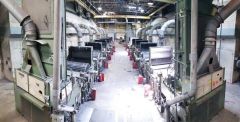 J-2364 LAROCHE SUPER OLYMPIC TEARING LINES, WW 1500mm, 6 CYLINDERS – NEW CONTROLS
J-2364 LAROCHE SUPER OLYMPIC TEARING LINES, WW 1500mm, 6 CYLINDERS – NEW CONTROLSMAKE: LAROCHE
MODEL: SUPER OLYMPIC
WIDTH: 1500mm
YEAR: MID 1980’S
6 CYLINDERS EACH LINE
CYLINDER DIAMETER: 1000mm
ALL CYLINDERS ARE DESIGNED FOR PINNED LAGS AND THERE IS LIFE LEFT IN MOST OF THE LAGS SETS.
LAGS: (1) 8mm x 135, (1) 10mm x 160, (1) 12 x 166, (3) 13mm x 174
EACH CYLINDER FED BY A FEED ROLL TO FEED DISH COMBINATION AND THE FIBER IS TRANSFERRED TO THE FOLLOWING CYLINDER VIA A CONDENSING SECTION.
MOTORS: 3 x 150 HP 575 VOLT
TOTAL REQUIRED POWER: 875 AMPS
NEW CONTROLS WITH ABB DRIVES
FEED CHUTES
LUMMUS BALERS
PINNED CYLINDERS
TEMAFA BLENDING BINS
EXIT CONVEYORS
EACH SECTION EQUIPPED WITH ANSUL DRY POWDER FIRE PROTECTION SYSTEM THAT IS ACTIVATED FROM EMBER DETECTED IN THE DUCT REMOVAL PIPING.
LINES INCLUDE ALL NECESSARY FANS, MAGNETS, DUCTING AND WIRINGIN PERFECT WORKING ORDER
QUANTITY: 2 LINES
Learn More -
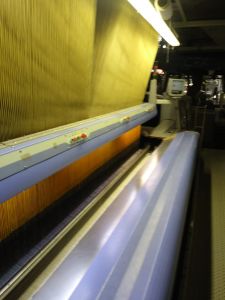 J-1817 SCHONHERR ALPHA 400 AUTOMATIC CARPET LOOM – CAM, 8 COLORS, YEAR 2012, JACQUARD
J-1817 SCHONHERR ALPHA 400 AUTOMATIC CARPET LOOM – CAM, 8 COLORS, YEAR 2012, JACQUARDJ-1817 SCHONHERR ALPHA 400 AUTOMATIC CARPET LOOM – CAM, 8 COLORS, YEAR 2012, JACQUARD
MAKE: SCHONHERR
MODEL: ALPHA 400 EASYSYSTEM, AUTOMATIC
WORKING WIDTH: 4000mm
CAM
YEAR: 2012
42 COMB
JACQUARDQUANTITY: 1
Learn More
